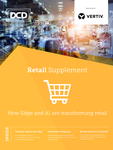The pandemic and its effects have shown us just how quickly situations can evolve and why we all need to be ready to manage change and mitigate risk. In the data center industry, we understand the need to manage risks from the very beginning. We know that issues such as interrupted power, cooling supply constraints and the ongoing need to find space to fit more computing resources are just some of the day-to-day challenges that need to be managed. However, 2020 has highlighted a new and pressing challenge that the data center industry needs to address, and address quickly – starting the digital transformation journey.
Starting the digital transformation journey
Digital transformation has made the headlines throughout 2020, largely because businesses had to switch up how they worked and ensure staff could work remotely. Digital transformation, however, is so much more than this. Gartner defines digital business transformation as “the process of exploiting digital technologies and supporting capabilities to create a robust new digital business model”. It is the focus on robustness that we in the data center industry need to be focusing on.
While it is easy to state the importance of starting a digital transformation journey, actually doing it is much harder. Those looking to increase the robustness and resilience of their data center operations need to ensure their digital transformation journey starts the right way.
Firstly, a digital transformation journey requires a reassessment and change to how teams work. This needs to include a greater focus on collaboration and using shared data to drive better performance. While the technology involved in digital transformation is important, getting the right processes in place first is the secret to success.
Creating collaboration
Supporting your digital transformation journey requires real-time, shared access to data. At the same time, you need to create a collaborative framework to work within. The best way to create this framework is to be open to changing your mindset on how you use the tools at your disposal.
Part of the problem that the data center industry faces is the sheer number of tools available. I wouldn’t be surprised if you told me you worked with 10 or more different toolsets just to keep your data center running at status quo. There are simply a lot of areas of risk to cover and consequently a lot of software out there to do it with. However, quite often these tools are siloed, even when overlapping coverage, meaning the users repeat work in the different applications.
This situation is very similar to that in the cybersecurity industry. In their efforts to mitigate the risk of a hack taking place, or data being lost, security professionals also end up with different toolsets that protect specific areas. Cybersecurity toolsets can therefore easily include systems such as firewalls, Virtual Private Networks (VPNs) and phishing email scanners to name but a few.
The connection between security and data centers was highlighted to me during a recent conversation I had with Jon Roadnight from CornerStone, a data center security consultancy business that specializes in a range of security design, engineering and risk management services.
Normally, security and simulation software don’t intersect, but we connected over the “mapping” nature of our software and services, specifically how both of our products map the data center space to reduce risk, albeit different types of risk. We realized there was synergy in how our tools worked, so wouldn’t it be great if our tools came together to change how we work?
Approaching your team’s digital transformation journey requires these types of conversations. Ask yourself: who are we aligned with and how can we work together? Identify potential partners and ask them the same thing, can we work together to change how we work? In short, communicate across data center silos to jump-start your digital transformation journey. Get the conversation started and watch how a collaborative framework changes the way you work.
Collaborating with the Digital Twin
While there is naturally a focus on the ‘digital’ part of digital transformation, it is at its most effective when the human elements of the business are better able to work together. Collaboration is a key part of this. Simulation software like the Digital Twin facilitates this by allowing teams to collaborate with greater ease and accuracy than previously possible.
By creating an identical replica of a data center to use for simulation, everyone from the data center designers to operators and business executives can work together to test out different setups and scenarios in a safe environment ahead of real-world deployments, reducing risk.
In the future, as the Digital Twin becomes ubiquitous within data center operations, we will see more software integrations appearing and new forms of analysis appearing. The Digital Twin has a lot to offer already, but right now we are still just scratching the surface of what is possible. The Digital Twin is more than simply a digital copy, just like a digital transformation journey is more than going virtual.
2020 has shown us how fragile the world is and how important it is to stay on top of managing risk. In 2021, the data center industry needs to take the next step in risk management and begin its digital transformation journey. The first step that businesses should take on that journey is implementing a Digital Twin that can foster the collaboration that businesses now need.





